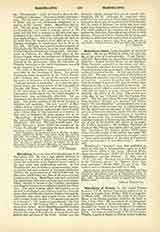

Manutius, ALDUS (ALDO MANUZIO), scholar and printer; b. in 1450, at Sermoneta, near Rome; died in 1515. He studied Latin at Rome and Greek at Ferrara. In 1482 he went to Mirandola, where he lived with his old friend, Giovanni Pico, continuing his Greek studies there for two years. He was appointed by Pico tutor to the latter’s nephews, Alberto and Lionello Pio, Princes of Carpi.
At Carpi, in 1490, Aldus conceived his brilliant and original project of establishing a Greek press at Venice. The funds for this great undertaking were supplied by his former pupil, Alberto Pio. Between the years 1494 and 1515 thirty-three first editions of all the greatest Greek authors were issued from the Al-dine press. Aldus’s house became a gathering-place for the learned Greek scholars of the time. The men employed by him in his work were almost all Greeks, and the prefaces to his great editions were almost always written in Greek. Aldus’s aim was to publish the best possible books at the lowest possible prices. The type used for his great library of Greek, Latin, and Italian authors, begun in 1501, was the italic, known as the Aldine, and said to have been adapted from the handwriting of Petrarch. It was cut by Francesco da Bologna, and had already been used (for the first time) in the edition of Virgil published in 1500. In 1493, or before that, the “Hero and Leander” of Musaeus was published. This was followed by the famous first edition of Aristotle, the first volume appearing in 1495, and the remaining four volumes in 1497 and 1498. The work was dedicated by Aldus to his patron, Alberto Pio.
In 1499 Aldus married the daughter of Andrea Torresano, of Asola, a Venetian printer. The two printing establishments were then combined and after that date the names of Aldus and Asolanus appeared on the title-pages of works from the Aldine Press. The device adopted by Aldus for the title-pages of his publications was the dolphin and anchor, with the motto, Festina lente. Within the next few years first editions of Aristophanes, Thucydides, Sophocles, Herodotus, Xenophon, Euripides, Demosthenes, Plato, Pindar, and others were produced at Venice. Besides these Greek authors, many Latin and Italian publications were put forth. In 1508 the great Dutch scholar, Erasmus, went to Venice and assisted in the publication of his “Proverbs” by the Aldine Press. In order to promote the study of Greek literature and the publication of Greek authors, Aldus, in 1500, founded the New Academy, or Aldine Academy of Hellenists. The members of this academy were required to speak Greek, and its rules were written in Greek. The organization comprised the most distinguished Greek scholars in Italy, who assisted Aldus in publishing the works of Greek and Latin authors. Under their direction the first Latin and Greek lexicon was given to the world.
Aldus was succeeded in the management of his great printing establishment by his son, Paulus Manutius (Paolo Manuzio), b. at Venice in 1512. He died in 1574. The work was then carried on by the latter’s son, Aldus, until his death in 1597.
EDMUND BURKE

